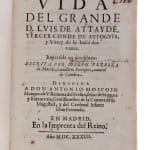![[India] Pereira de Macedo, Francisco de Santo Agostinho (1596-1681), Vida del grande d. Lvis de Attayde, tercer Conde de Attogvia, y Virrey de la India dos vezes, 1633. Madrid. Imprenta del Reino.](https://artlogic-res.cloudinary.com/w_1600,h_1600,c_limit,f_auto,fl_lossy,q_auto/artlogicstorage/hsrarebooks/images/view/b19efc668a3bbf4f626f1b7810ebae9bj/hsrarebooks-india-pereira-de-macedo-francisco-de-santo-agostinho-1596-1681-vida-del-grande-d.-lvis-de-attayde-tercer-conde-de-attogvia-y-virrey-de-la-india-dos-vezes-1633.-madrid.-.jpg)
![[India] Pereira de Macedo, Francisco de Santo Agostinho (1596-1681), Vida del grande d. Lvis de Attayde, tercer Conde de Attogvia, y Virrey de la India dos vezes, 1633. Madrid. Imprenta del Reino.](https://artlogic-res.cloudinary.com/w_1600,h_1600,c_limit,f_auto,fl_lossy,q_auto/artlogicstorage/hsrarebooks/images/view/1b1754e4327fd3d58c8d296f2a9190f5j/hsrarebooks-india-pereira-de-macedo-francisco-de-santo-agostinho-1596-1681-vida-del-grande-d.-lvis-de-attayde-tercer-conde-de-attogvia-y-virrey-de-la-india-dos-vezes-1633.-madrid.-.jpg)
![[India] Pereira de Macedo, Francisco de Santo Agostinho (1596-1681), Vida del grande d. Lvis de Attayde, tercer Conde de Attogvia, y Virrey de la India dos vezes, 1633. Madrid. Imprenta del Reino.](https://artlogic-res.cloudinary.com/w_1600,h_1600,c_limit,f_auto,fl_lossy,q_auto/artlogicstorage/hsrarebooks/images/view/396adcde9a92daa17394df4ae9d47350j/hsrarebooks-india-pereira-de-macedo-francisco-de-santo-agostinho-1596-1681-vida-del-grande-d.-lvis-de-attayde-tercer-conde-de-attogvia-y-virrey-de-la-india-dos-vezes-1633.-madrid.-.jpg)
![[India] Pereira de Macedo, Francisco de Santo Agostinho (1596-1681), Vida del grande d. Lvis de Attayde, tercer Conde de Attogvia, y Virrey de la India dos vezes, 1633. Madrid. Imprenta del Reino.](https://artlogic-res.cloudinary.com/w_1600,h_1600,c_limit,f_auto,fl_lossy,q_auto/artlogicstorage/hsrarebooks/images/view/7eb72188c342cd141dabf509cddeaa2aj/hsrarebooks-india-pereira-de-macedo-francisco-de-santo-agostinho-1596-1681-vida-del-grande-d.-lvis-de-attayde-tercer-conde-de-attogvia-y-virrey-de-la-india-dos-vezes-1633.-madrid.-.jpg)
![[India] Pereira de Macedo, Francisco de Santo Agostinho (1596-1681), Vida del grande d. Lvis de Attayde, tercer Conde de Attogvia, y Virrey de la India dos vezes, 1633. Madrid. Imprenta del Reino.](https://artlogic-res.cloudinary.com/w_1600,h_1600,c_limit,f_auto,fl_lossy,q_auto/artlogicstorage/hsrarebooks/images/view/0c8021156eea4e700c73f9470e919d97j/hsrarebooks-india-pereira-de-macedo-francisco-de-santo-agostinho-1596-1681-vida-del-grande-d.-lvis-de-attayde-tercer-conde-de-attogvia-y-virrey-de-la-india-dos-vezes-1633.-madrid.-.jpg)
[India] Pereira de Macedo, Francisco de Santo Agostinho (1596-1681)
Vida del grande d. Lvis de Attayde, tercer Conde de Attogvia, y Virrey de la India dos vezes, 1633. Madrid. Imprenta del Reino.
Rare biography of a two-term 16th century Viceroy of India
Rare first and only edition of this biography of Don Luis de Ataide (1517-1581), Viceroy of Portuguese India twice, famous for his defense of India from the Muslim alliance, by the Jesuit Pereira de Macedo
Rare first and only edition of this biography of Don Luis de Ataide (1517-1581), Viceroy of Portuguese India twice, famous for his defense of India from the Muslim alliance, by the Jesuit Pereira de Macedo
$ 6,500.00
Further images
4to, (197 x 145 mm). 6 ff.,168 pp. Contemporary vellum, spine lettered in ink, some spot marks, else fine. Ownership inscription to title page slightly oxidized causing irrelevant loss, near contemporary manuscript note correcting the author’s name, some spotting and leaves browned as expected for the paper used at the time in Spain.
Ataide served twice as Viceroy of India, the first from 1568 to 1571, and the second from 1578 to 1581, after his first reign, he was well-received by the court in Portugal as the defender of India, and died acting as Viceroy during his second reign, in Goa (1581). Before he had gained some fame fighting in Africa and for his participation in Esteban de Gama’s expedition to the Red Sea, where he was knighted in Mount Sinai; he was later sent to the court of Emperor Charles V and took part of his expedition against the Lutherans. During his second period as Viceroy, the battle of Alcazarquivir occurred, which sent Portugal into turmoil and political unrest following the death of theKing Dom Sebastian, leaving no heirs and leading to the union of the Crown with Spain.“He was named viceroy at a critical period for the Portuguese authority inIndia. An alliance had been concluded by the Nizam, the Zamorin of Malabar, and the Chief of Canara and Balagat, with a view by their combined forces to drive the Portuguese out of India. Ataide landed in India, in October, 1568. The allies had not yet made any decisive movement, and he had time allowed him to visit and place in a state of defense the principal stations occupied by the Portuguese. His activity appears to have caused the allies to pause in their hostile intentions, for two years elapsed before they came to open hostilities. This interval was employed by Ataide in promoting expeditions of discovery and experimental trading both to the east and the west of Goa” (The Biographical Dictionary of the Society for the diffusion of useful knowledge, p.855). Although in the title the author’s name appears as Joseph, it is known the author was in fact Francisco de Santo Agostinho, a prodigious writer, theologist, historian and scholar: “Fecundisimo escritor… ingreso en la Compania de Jesus… Tal vez por su character violento, ya en edad madura, en 1642, abandon la Compania para vestir el habito franciscano” (GonzaloDiaz Diaz, Hombres y documentos de la filosofía Española); “At eleven, hecould repeat the Eneid, and composed verses, which not only imitated, but exceeded Virgil… After having made the fourth vow among the Jesuits, he quit the order to exculpate himself from some alleged crime, in which, says Barbose ‘credulity was more concerned than malice’…” (Southey's common-place book. Ed. by J.W. Warter, Vol. 2, p.235).We can locate copies at the Biblioteca Nacional de Portugal, LOC, Newberry library, University of Wisconsin, Brandeis university library, BNE, and BNF.Palau, 145729; Salva, 3486; De Backer Sommervogel, 245, 9; Barbosa Machado, II, 88; for the author, see pp. 83-96. Innocêncio II, 322-3 (refers to a1629 edition, cited by Ternaux-Compans, which is in all probability a ghost, since we could find no reference to an extant copy with this date). GarciaPeres, Autores portugueses que escrbieren en castellano, pp. 337-9. Porbase provides a record for this book, but without locating any copies.
Ataide served twice as Viceroy of India, the first from 1568 to 1571, and the second from 1578 to 1581, after his first reign, he was well-received by the court in Portugal as the defender of India, and died acting as Viceroy during his second reign, in Goa (1581). Before he had gained some fame fighting in Africa and for his participation in Esteban de Gama’s expedition to the Red Sea, where he was knighted in Mount Sinai; he was later sent to the court of Emperor Charles V and took part of his expedition against the Lutherans. During his second period as Viceroy, the battle of Alcazarquivir occurred, which sent Portugal into turmoil and political unrest following the death of theKing Dom Sebastian, leaving no heirs and leading to the union of the Crown with Spain.“He was named viceroy at a critical period for the Portuguese authority inIndia. An alliance had been concluded by the Nizam, the Zamorin of Malabar, and the Chief of Canara and Balagat, with a view by their combined forces to drive the Portuguese out of India. Ataide landed in India, in October, 1568. The allies had not yet made any decisive movement, and he had time allowed him to visit and place in a state of defense the principal stations occupied by the Portuguese. His activity appears to have caused the allies to pause in their hostile intentions, for two years elapsed before they came to open hostilities. This interval was employed by Ataide in promoting expeditions of discovery and experimental trading both to the east and the west of Goa” (The Biographical Dictionary of the Society for the diffusion of useful knowledge, p.855). Although in the title the author’s name appears as Joseph, it is known the author was in fact Francisco de Santo Agostinho, a prodigious writer, theologist, historian and scholar: “Fecundisimo escritor… ingreso en la Compania de Jesus… Tal vez por su character violento, ya en edad madura, en 1642, abandon la Compania para vestir el habito franciscano” (GonzaloDiaz Diaz, Hombres y documentos de la filosofía Española); “At eleven, hecould repeat the Eneid, and composed verses, which not only imitated, but exceeded Virgil… After having made the fourth vow among the Jesuits, he quit the order to exculpate himself from some alleged crime, in which, says Barbose ‘credulity was more concerned than malice’…” (Southey's common-place book. Ed. by J.W. Warter, Vol. 2, p.235).We can locate copies at the Biblioteca Nacional de Portugal, LOC, Newberry library, University of Wisconsin, Brandeis university library, BNE, and BNF.Palau, 145729; Salva, 3486; De Backer Sommervogel, 245, 9; Barbosa Machado, II, 88; for the author, see pp. 83-96. Innocêncio II, 322-3 (refers to a1629 edition, cited by Ternaux-Compans, which is in all probability a ghost, since we could find no reference to an extant copy with this date). GarciaPeres, Autores portugueses que escrbieren en castellano, pp. 337-9. Porbase provides a record for this book, but without locating any copies.
Join our mailing list
* denotes required fields
We will process the personal data you have supplied in accordance with our privacy policy (available on request). You can unsubscribe or change your preferences at any time by clicking the link in our emails.





